More on this book
Community
Kindle Notes & Highlights
“our aim is to formulate a set of laws that will enable us to predict events up to the limit set by the uncertainty principle.” So, science is built upon the complementarity of being and becoming: the (presumably) unchanging laws of Nature describe all variety of natural phenomena.
While Thales and his followers argued with Parmenides about being and becoming, Pythagoras was founding a mystical-philosophical society in southern Italy with the goal of expressing all of Nature in terms of numbers.
To ask deep questions about Nature is, ultimately, to want to know the mind of God.
To understand Nature was, quite literally, a religious mission, to decipher God’s plans for the world.
Hawking proposed that the initial state of the universe was one of timelessness. Nothing ever happened; the universe just was. “The universe would be neither created nor destroyed. It would just be,” he wrote. Parmenides would be proud. Here is a modern scientific version of the universe of being. Ironically, Hawking put forward this idea during a conference in the Vatican, not yet knowing that it would have serious theological implications. For one thing, a universe that is neither created nor destroyed, that is, a universe that is uncreated, does not need a Creator. What would be the role of
...more
Religions get away with this by making use of supernatural arguments such as “God exists outside time and hence is uncreated and uncaused.”
The story that Newton was hit on the head by an apple is almost certainly apocryphal.
In an infinite universe, every point can be regarded as the center because every point has an infinite number of stars on each side of it.


